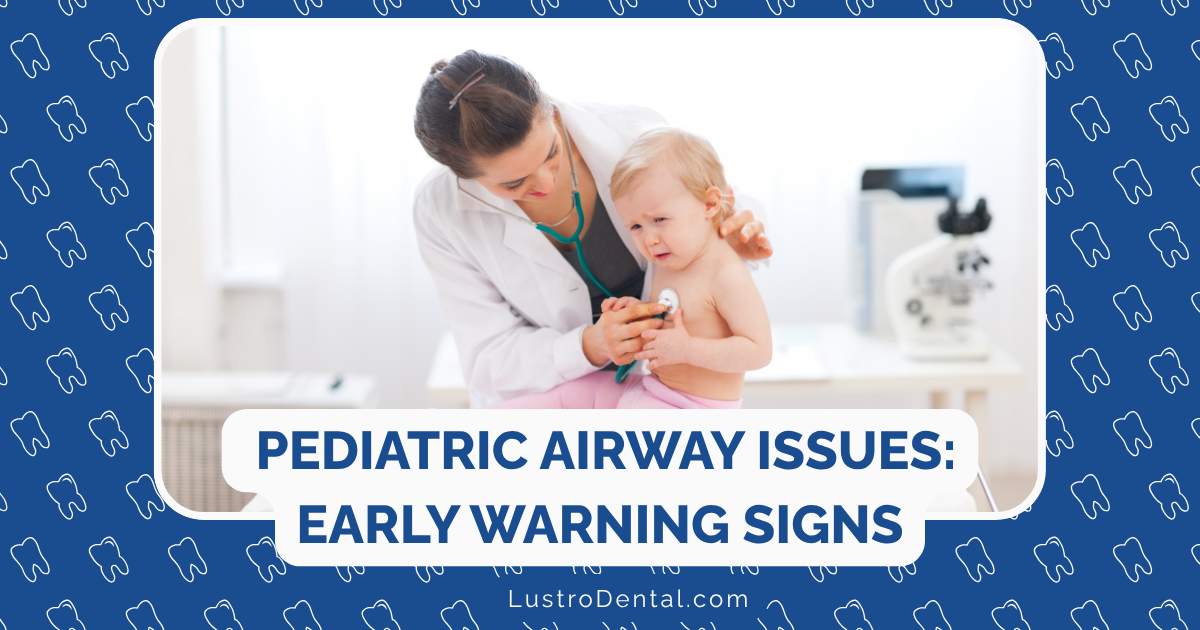Recognizing Airway Issues in Children: Signs Parents Should Watch For

As parents, we’re constantly on alert for signs that something might be affecting our children’s health. While fever or a cough might prompt immediate attention, subtler issues—particularly those related to breathing and sleep—can go unrecognized for years, potentially impacting a child’s development, behavior, and overall wellbeing.
Pediatric airway issues are surprisingly common, affecting approximately 10% of children who snore regularly and 2-4% who experience obstructive sleep apnea, according to the American Academy of Otolaryngology. Yet many cases go undiagnosed because the signs aren’t always obvious.
As a dental health advocate with a focus on airway health, I want to help parents recognize the warning signs of potential airway issues in their children. Early identification and intervention can make a tremendous difference in your child’s quality of life, learning ability, and even facial development.
Understanding Pediatric Airway Issues
Airway issues in children encompass a spectrum of conditions that affect breathing, particularly during sleep. These include:
- Obstructive Sleep Apnea (OSA): When breathing repeatedly stops and starts during sleep due to blocked upper airways
- Upper Airway Resistance Syndrome (UARS): Increased effort to breathe during sleep, causing sleep fragmentation
- Habitual Mouth Breathing: Breathing through the mouth instead of the nose, often due to nasal obstruction
- Laryngomalacia: A softening of the tissues of the larynx (voice box) that can cause noisy breathing
These conditions can have significant impacts on a child’s health, behavior, and development if left untreated. Let’s explore the signs that might indicate your child is experiencing airway issues.
Physical Signs to Watch For
1. Breathing Patterns
Mouth Breathing: One of the most visible signs of potential airway issues is consistent mouth breathing, especially during the day. Children should primarily breathe through their nose, which filters, warms, and humidifies air before it reaches the lungs.
Signs of mouth breathing include:
- Consistently parted lips, especially at rest
- Dry lips or cracked corners of the mouth
- Frequent sipping of water due to dry mouth
- Speaking with a “wet” sound or “slushy” speech
Noisy Breathing: Listen for:
- Snoring (more than 3 nights per week is considered habitual)
- Gasping or choking sounds during sleep
- Audible breathing during rest or light activity
- Wheezing or whistling sounds when breathing
2. Facial and Dental Characteristics
Chronic mouth breathing and airway issues can actually affect how a child’s face and jaw develop. Look for:
- Long, narrow face
- Flat cheekbones or underdeveloped middle face
- Gummy smile or receding chin
- Dark circles under the eyes (allergic shiners)
- Forward head posture
- Narrow dental arches or crowded teeth
- High-arched palate (roof of the mouth)
According to a 2025 study from OrthoBar, these facial characteristics often develop as the body adapts to airway restrictions, potentially leading to long-term structural issues if not addressed early.
3. Sleep Behaviors
Disrupted sleep due to breathing difficulties can manifest in various ways:
- Restless sleep with frequent position changes
- Unusual sleeping positions (such as neck extension, sleeping on hands and knees, or with head hanging off the bed)
- Excessive sweating during sleep
- Bedwetting (especially if it begins after a period of dryness)
- Nightmares or night terrors
- Sleepwalking or sleep talking
- Grinding teeth during sleep (bruxism)
A Houston ENT study notes that these sleep disturbances often occur as the body attempts to maintain oxygen levels during sleep.
Behavioral and Developmental Signs
Airway issues don’t just affect physical health—they can significantly impact behavior, learning, and development. Watch for these potential indicators:
1. Daytime Behaviors
- Excessive daytime sleepiness: Falling asleep in school or during quiet activities
- Hyperactivity: Paradoxically, sleep deprivation in children often presents as hyperactivity rather than tiredness
- Difficulty concentrating: Short attention span or easy distractibility
- Irritability or moodiness: Frequent emotional outbursts or mood swings
- Morning headaches: Due to disrupted sleep and possibly reduced oxygen levels
- Poor appetite: Especially at breakfast, possibly due to a sore throat from mouth breathing
2. Academic and Developmental Concerns
- Learning difficulties despite adequate intelligence
- Speech delays or articulation problems
- Poor academic performance
- Difficulty with memory or following instructions
- Delayed growth or failure to thrive
Research from the Children’s Airway First Foundation indicates that sleep-disordered breathing can damage the prefrontal cortex of a child’s brain, potentially affecting attention, behavior, and learning abilities. In fact, children with airway issues are 50% more likely to be diagnosed with ADHD or ADD, according to Sarasota Children’s Dentistry.
When to Seek Medical Attention
While some signs might seem minor in isolation, multiple symptoms warrant professional evaluation. Contact your child’s healthcare provider if you notice:
Immediate Concerns (Seek Help Promptly)
- Pauses in breathing during sleep lasting more than 10 seconds
- Gasping, choking, or snorting sounds that wake your child
- Blue or purple coloration of the lips or face during sleep
- Extreme difficulty breathing during sleep or waking with a feeling of choking
Schedule an Evaluation If You Notice:
- Habitual snoring (more than 3 nights per week)
- Consistent mouth breathing, especially during the day
- Multiple behavioral or sleep symptoms mentioned above
- Facial features suggesting potential airway issues
- Academic or behavioral problems with no other clear cause
The Dental Connection to Airway Health
You might wonder why a dental health advocate is discussing breathing issues. The connection between dental development and airway health is profound and often overlooked.
The shape and position of the jaws directly affect the size and patency of the airway. Conversely, chronic mouth breathing can lead to altered facial growth and dental development. This is why dentists and orthodontists are increasingly at the forefront of identifying potential airway issues in children.
Signs that might be noticed during a dental examination include:
- Narrow dental arches
- Crowded teeth or significant overbite
- High, narrow palate
- Signs of teeth grinding (worn enamel)
- Enlarged tonsils visible during oral examination
- Tongue tie or restricted tongue movement
Early orthodontic evaluation is recommended by age 7, not just for alignment concerns but also to assess airway and breathing patterns. According to WGM Orthodontics, mouth breathing can signal a narrow palate or airway obstruction that impacts jaw development and may require early intervention.
Common Causes of Pediatric Airway Issues
Understanding potential causes can help parents identify risk factors and seek appropriate care:
Anatomical Factors
- Enlarged tonsils and adenoids: The most common cause of sleep-disordered breathing in children
- Small or recessed jaw (retrognathia): Creates less space for the tongue
- Tongue tie: Can affect tongue positioning and function
- Nasal septum deviation: May obstruct nasal breathing
- Craniofacial abnormalities: Such as cleft palate or Pierre Robin sequence
Medical Conditions
- Allergic rhinitis: Causes nasal congestion and promotes mouth breathing
- Asthma: Can contribute to breathing difficulties
- Obesity: Excess tissue can narrow the airway
- Gastroesophageal reflux disease (GERD): Can cause inflammation of airway tissues
Environmental Factors
- Secondhand smoke exposure: Irritates airway tissues
- Allergens in the home: Can cause chronic nasal congestion
- Air pollution: May contribute to respiratory issues
Treatment Approaches for Pediatric Airway Issues
If you suspect your child has airway issues, various treatment options are available depending on the cause and severity:
Non-Surgical Interventions
- Myofunctional therapy: Exercises to strengthen oral and facial muscles
- Orthodontic treatments: Including palatal expansion to widen the upper jaw and create more space for nasal breathing
- Allergy management: Medications or environmental changes to reduce nasal congestion
- Positional therapy: Teaching children to sleep in positions that maximize airway patency
- CPAP therapy: For moderate to severe cases of sleep apnea
Surgical Options
- Tonsillectomy and adenoidectomy: Removal of enlarged tonsils and adenoids
- Frenectomy: Release of tongue or lip ties that may affect breathing or swallowing
- Turbinate reduction: Reducing the size of nasal structures that may be blocking airflow
Lifestyle Modifications
- Weight management: For children where obesity is contributing to airway issues
- Nasal hygiene: Including saline rinses to improve nasal breathing
- Sleep hygiene: Establishing consistent sleep routines and creating an optimal sleep environment
The Importance of a Multidisciplinary Approach
Addressing pediatric airway issues often requires collaboration between multiple healthcare providers:
- Pediatricians: For initial evaluation and coordination of care
- ENT specialists (Otolaryngologists): To assess and treat structural issues like enlarged tonsils
- Sleep specialists: For sleep studies and comprehensive sleep disorder management
- Dentists and orthodontists: To evaluate and address dental and jaw development concerns
- Myofunctional therapists: To help retrain breathing and oral muscle patterns
- Allergists: To manage allergic contributions to nasal obstruction
Taking Action: Next Steps for Concerned Parents
If you’ve recognized potential airway issues in your child, here are practical next steps:
- Document your observations: Keep a sleep diary noting snoring, restless sleep, unusual positions, and daytime symptoms.
- Record evidence: If possible, take video of your child sleeping to share with healthcare providers.
- Consult your pediatrician: Discuss your concerns and bring your documentation.
- Request appropriate referrals: Ask about sleep studies, ENT evaluation, or dental assessment as needed.
- Consider a dental evaluation: Even if your child is young, a pediatric dentist or orthodontist trained in airway health can provide valuable insights.
- Be persistent: If your concerns are dismissed but symptoms persist, seek a second opinion, preferably from a provider with specific interest in pediatric sleep and breathing disorders.
Conclusion: Breathing for Optimal Development
Proper breathing is fundamental to a child’s growth, development, and overall wellbeing. By recognizing the signs of potential airway issues early, parents can play a crucial role in ensuring their children receive appropriate care.
Remember that many of these symptoms can have other causes, and not every child who snores or breathes through their mouth has a significant airway disorder. However, when multiple signs are present, or when symptoms affect quality of life, learning, or development, professional evaluation is warranted.
With early intervention, many children with airway issues can experience dramatic improvements in sleep quality, behavior, learning ability, and long-term health outcomes. As parents, your observations and advocacy are essential first steps in this process.
Have you noticed any of these signs in your child? What was your experience seeking help? Share your thoughts in the comments below.







